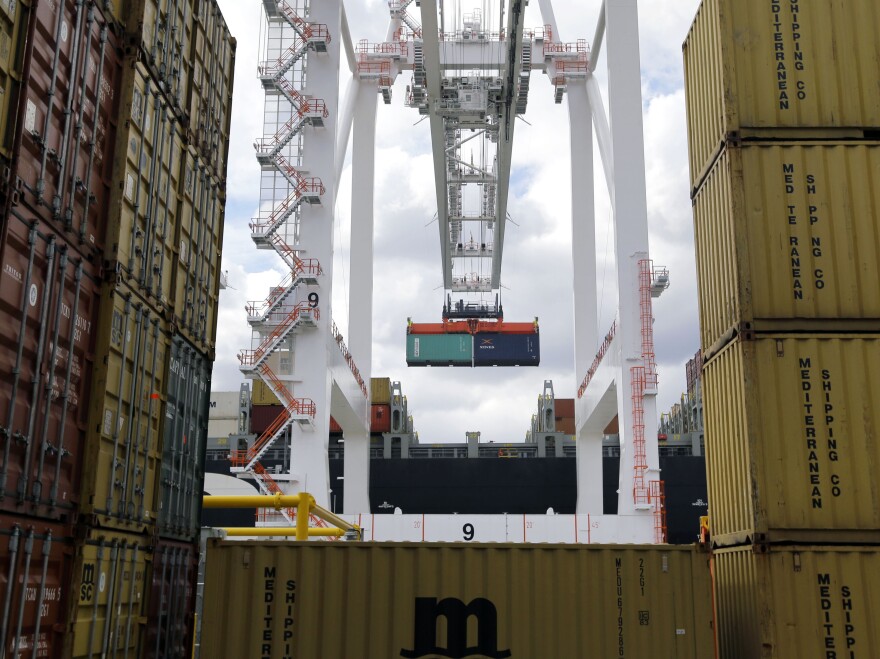There is constant motion around four new supersized, Chinese-made cranes as they unload cargo from a ship at the Port of Baltimore's freshly constructed Seagirt Marine Terminal.
Control cabs whir across the cranes' broad steel beams, and thick cables spin from giant wheels. Containers packed with consumer goods — TVs, clothing and the like — are hoisted from the ship and transferred to a flatbed truck waiting 140 feet below; the truck then peels away and is immediately replaced by another. It's a fluid, seemingly effortless process — surprising considering the size of each crane.
"If you look at one of these cranes, you would be looking at a 40-story building," says Mark Schmidt, the terminal manager. "With the boom up and fully erected, they're about 400 feet tall."
Schmidt is with Ports America, which signed a 50-year lease with the Maryland Port Administration to operate the terminal. Ports America invested roughly $250 million in the project, in expectation of the widening of the Panama Canal.
'A Significant Change'
When the project to widen the canal is completed in 2015, longer and wider ships will be able to pass through its locks, giving them access to ports on the Gulf of Mexico and the East Coast. But at the moment, the Port of Baltimore is one of only two on the East Coast (the other is the Port of Virginia in Norfolk) that can handle the large cargo ships, known as post-Panamax ships. It recently completed a major expansion, which included building a 50-foot berth and dredging the channel.
Mark Montgomery, the president of Ports America Chesapeake, says much rides on the canal's expansion.
"It will allow a ship that is three times as big to come through the canal once the widening project is finished," he says. "It's a significant change in maritime economics."
Bigger ships mean more cargo containers, which can translate into an economic windfall for a port, says Adie Tomer, a transportation and infrastructure specialist at the Brookings Institution.

He says since it was announced that the Panama Canal was being widened, there's been an "arms race" between ports across the country.
"What that arms race has kind of been about is based on this assumption that with a snap of the finger, of when the canal widens, all of a sudden, massive new ships carrying extremely large loads of containers will be entering and exiting ports in the states," Tomer says.
West Coast Ports Affected
He says Baltimore and Norfolk have a competitive edge as companies begin to choose what ports to use once the canal's expansion is complete. But it's not good news for West Coast ports such as the Port of Los Angeles and Port of Long Beach, where megaships from Asia have docked since the mid-1990s.
Khalid Bachkar, an assistant professor at the California Maritime Academy, says the West Coast ports accounted for about 75 percent of all Asian imports.
"The ship will come to the West Coast, and then [cargo] will be transported via rail to New York," he says. "However, now, with the opening of the Panama Canal, there are many competitors."
Bachkar says within the next decade, many more ports on the East Coast — such as New York — and in the Gulf will build up their infrastructure and dredge their channels in order to accommodate the huge container ships.
Tomer of the Brookings Institution says in the world of international shipping, a multitude of dynamics determine a port's fortunes.
"Even though we might feel like we're in competition with one another, we're also in competition with other ports across the globe," he says, "new ports opening on the Mediterranean side, of course in Southeast Asia are expanding, even beyond the classic Chinese ports."
Tomer says there's no guarantee that trade will always move in the same direction and between the same markets.
James White, executive director of Maryland Port Administration, says he agrees. Already, he says, the manufacturing base is starting to shift from Asia to Southeast Asia — to countries such as Cambodia and Vietnam.
"I think we're probably going to see, within the next five to 10 years, most of the transits, if that continues, to come to the Suez Canal, with the Panama Canal getting maybe some overflow," he says.
Copyright 2021 NPR. To see more, visit https://www.npr.org.



